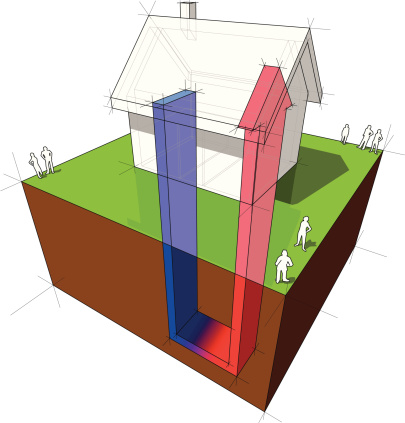 If you were the type of kid – or are now the type of adult – who literally dug the earth, then you'll probably dig the idea of a geothermal heating system. And that's one pun that's intended.
If you were the type of kid – or are now the type of adult – who literally dug the earth, then you'll probably dig the idea of a geothermal heating system. And that's one pun that's intended.
Just as its prefix – “geo,” for earth – implies, this type of system relies on the steady temperature of the earth rather than the unpredictable outside air as an exchange medium to heat a home.
Here's how this fascinating system works:
A series of pipes, called a loop, is buried underground. A geothermal heat pump collects the earth's natural thermal energy through these pipes. Water circulates through the pipes and carries the heat to a home, where a heat exchanger and compressor work to distribute the heat through ductwork. In the summer, the process is reversed: the loops draw excess heat from a home and send it back to be absorbed by the earth. So in a nutshell, the system serves as a heat source in the winter and a heat "pool" in the summer.
Other names for the same type of system:
Geothermal heating systems or geothermal heat pumps are the most common names for this type of system, though they also are referred to as earth-coupled, geo-exchange, ground-source or water-source heat pumps. But the idea is the same: the pipes are buried underground, where temperatures are warmer than above-ground air during the winter and cooler than above-ground air during the summer. In fact, while above-ground temperatures can fluctuate wildly – even in Northern California – temperatures 6 feet below ground usually range between 45 and 75 degrees.
Advantages of geothermal systems:
Geothermal heating systems are hardly some newfangled scientific discovery; they surfaced during the 1940s, and about 50,000 American homeowners have them installed every year. This earth-based system offers many advantages, including:
- Substantial energy savings – to the tune of between 25 and 50 percent a year, depending on the climate, soil conditions and the system features, according to the U.S. Environmental Protection Agency
- A long system life – or about 25 years for the interior components and more than 50 years for the loops – and little maintenance
- They don't burn fossil fuel, like a furnace
- They are much quieter than a traditional air-source heating system
Much like a solar energy system, a geothermal heating system isn't exactly inexpensive to install. In fact, the U.S. Department of Energy says it can cost “several times” more to install a geothermal heating system than an air-source system. However, homeowners can expect to recoup the investment in energy savings in between 5 and 10 years.
Important things to consider:
If you're ready to start digging – literally, again – into the idea of having a geothermal heating system installed, three factors will be important:
- The amount of land space you have available (the more, the better)
- The soil conditions on your property (the more pliable, the better)
- Hydrology, or the amount of available water on your property
Without getting overly technical, you should know that there are four types of ground loop systems. Three of these – horizontal loops, vertical loops and pipes that run from a pond or lake -- are closed-loop systems. The fourth type of system is an open-loop system, which uses well or ground water as a heat exchange fluid.
Most people face a choice between the horizontal- or vertical-loop system. The open-loop system is less common because it depends on an ample supply of clean water to function.
To learn more about geothermal heating systems, if they're right for your home, and if they're offered in your area, contact a local heating system service company.
Next time you need a heating system service or repair contact Experts In Your Home!
Related Articles:
Things to Consider Before Purchasing a New Heating System
Things to Consider About Your Heating System When Building a New Home








